Solving Dynamic Multi-Objective Flexible Job Shop Scheduling Problems Using a Dual-Level Integrated Deep Q-Network Approach
Abstract
1. Introduction
- State Feature Extraction: Six state features are extracted and normalized to the range [0, 1] to accurately represent the system’s state at each rescheduling point. These features are specifically designed to account for six types of dynamic events: new job insertions, job cancellation, job operation modification, machine addition, machine tool replacement and machine breakdown. By normalizing state features, the model’s adaptability and convergence speed can be significantly improved.
- Composite Dispatching Rule Design: Three job selection rules and three machine assignment rules are formulated, resulting in nine composite dispatching rules through pairwise combinations. These rules constitute the agent’s action space, addressing both job sequencing and machine allocation tasks. They exhibit strong generalization capabilities, making them suitable for scheduling problems across various production configurations.
- Dual-Level Integrated Deep Q-Network (DLIDQN): This paper proposes a Dual-Level Integrated Deep Q-Network (DLIDQN) framework, which combines various customized network architectures and employs a dual-level structure to enhance the efficiency and accuracy of scheduling decisions. The framework consists of high-level and low-level IDQN agents. The high-level IDQN is responsible for strategy decision-making, analyzing state features to set optimization goals for the low-level agent (using different reward functions). The low-level IDQN operates at the execution layer, calculating the Q-values for each dispatching rule and selecting the optimal scheduling action based on the optimization goals set by the high-level agent. At each rescheduling point, the framework dynamically adjusts strategies through an efficient collaboration mechanism, maximizing cumulative rewards, thereby significantly improving decision-making efficiency and enhancing adaptability to dynamic environmental changes.
- Multi-Objective Optimization and Local Search Algorithm: This paper optimizes three key indicators: makespan, average machine utilization, and average job tardiness rate. Two high-level optimization goals are defined to balance these objectives, each with its own reward function during training. To further improve scheduling performance and stability, a specialized local search algorithm is introduced to ensure the quality and stability of the scheduling solution.
2. Literature Review
3. Preliminaries
3.1. Definition of RL and Q-Learning
3.2. Definition of Deep Q-Learning
3.3. Definition of IDQN
4. DMOFJSP Formulation
- Each machine is capable of processing only one operation at a given time.
- All operations within each job are required to adhere to a predetermined priority sequence and must be processed without interruption.
- Job transportation times and machine setup time are disregarded in this study.
- Each job is assigned a specific delivery deadline. Jobs not completed by their deadlines are classified as late, with their delays duly recorded.
- The arrival times of jobs may differ. When a new job is introduced, all ongoing operations are allowed to finish before the remaining operations and the newly added job proceed to the scheduling stage to formulate a revised production plan.
- If a task must be canceled, the system ceases the current process and shifts all remaining tasks to the scheduling stage in order to devise a fresh production plan.
- Job operation modification involves expanding the existing job by introducing new operations. Once the current operation is completed, the additional operations will be integrated into the job, and all remaining tasks will be transferred to the rescheduling phase to develop a new production plan.
- The process of machine addition refers to the system’s ability to deploy additional machines. After the completion of current tasks by all machines, the system will assess the average machine utilization . If is higher than a given threshold, new machines will be introduced and integrated into the new scheduling plan.
- Machines are capable of switching between different processing types by replacing tools. During the tool replacement process, machines enter a conversion state and temporarily halt operations. The processing time for a machine accounts for the additional time required for tool changes.
- When a machine experiences a breakdown, it transitions into a repair state. If alternative machines are unavailable, the affected job enters a blocked state. Upon completion of the machine repair, the job exits the blocked state, and all jobs re-enter the scheduling phase with an updated production plan.
- If no available machine is able to process the current operation, the job enters a blocked state. Once the final operation of the job is completed, the job transitions into a finished state, and no further processing is carried out.
5. Methods for DMOFJSP
5.1. Definition of State Features
5.1.1. Detailed Definitions and Formula Explanations
5.1.2. Impact of State Feature Changes on Scheduling Decisions
- Changes in : If the increases from 50% to 80%, the scheduling system may adjust accordingly. For example, the system may determine that machine resources are being well-utilized and decide to increase the workload by scheduling more jobs. Additionally, the system may assign new jobs to machines with lower utilization rates to balance the workload and avoid overloading specific machines.
- Changes in : When the increases, it means most jobs are nearly finished. In this case, the scheduling system may shift focus to newly inserted or unstarted jobs, prioritizing them over those that are almost complete. The system may also delay the start of some new jobs to prevent congestion, which helps improve resource allocation and overall efficiency.
- Changes in : If the increases, it indicates potential delays, possibly due to machine breakdowns or resource shortages. The scheduling system may respond by prioritizing jobs with higher tardiness rates, ensuring that critical tasks are completed on time. It may also reassign resources, such as moving delayed jobs to idle machines or prioritizing repairs on affected machines, to reduce overall delays and improve performance.
5.2. Definition of Proposed Composite Dispatching Rules
5.2.1. Scheduling Rule 1 for Sub-Task 1
| Algorithm 1: Procedure for Dispatching Rule 1 in Sub-task 1 |
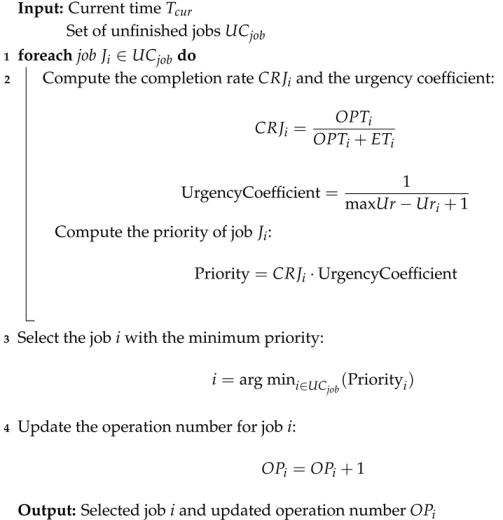 |
5.2.2. Scheduling Rule 2 for Sub-Task 1
| Algorithm 2: Procedure for Dispatching Rule 2 in Sub-task 1 |
 |
5.2.3. Scheduling Rule 3 for Sub-Task 1
| Algorithm 3: Procedure for Dispatching Rule 3 in Sub-task 1 |
|
Input: Current time Set of unfinished jobs
|
5.2.4. Scheduling Rule 1 for Sub-Task 2
| Algorithm 4: Procedure for Dispatching Rule 1 in Sub-task 2 |
 |
5.2.5. Scheduling Rule 2 for Sub-Task 2
| Algorithm 5: Procedure for Dispatching Rule 2 in Sub-task 2 |
 |
5.2.6. Scheduling Rule 3 for Sub-Task 2
| Algorithm 6: Procedure for Dispatching Rule 3 in Sub-task 2 |
Input: Current time Operation Set of compatible machines Output: Selected machine |
5.3. Definition of Reward Function
| Algorithm 7: Reward Calculation Based on or |
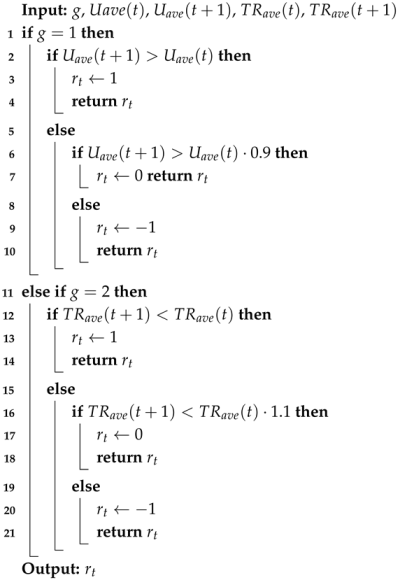 |
5.4. Local Search Algorithm
| Algorithm 8: Local Search Process |
 |
5.5. The Network of the DLIDQN
6. Numerical Experiments
6.1. Training Process
6.2. Testing Settings
6.3. Comparisons with the Proposed Composite Dispatching Rules
6.4. Comparisons with Classic Dispatching Rules
- First In First Out (FIFO): Decide the next operation to start based on the arrival time of jobs, selecting the next operation for the job that arrived first.
- Earliest Due Date (EDD): Sort jobs by their due dates and choose the next operation for the job with the earliest due date to ensure timely delivery.
- Shortest Processing Time (SPT): Schedule based on the estimated shortest time required to complete each job, selecting the next operation for the job with the shortest processing time.
- Longest Processing Time (LPT): Opposite to SPT, choose the job with the longest processing time, typically used for optimizing resource allocation to expedite the processing of tasks that have been waiting longer.
- Most Remaining Processing Time (MRT): Consider jobs with the most remaining processing time (those with the longest remaining time) to balance the overall schedule.
6.5. Comparisons with Other RL-Based Scheduling Algorithms
| Algorithm 9: DQN Reward Algorithm |
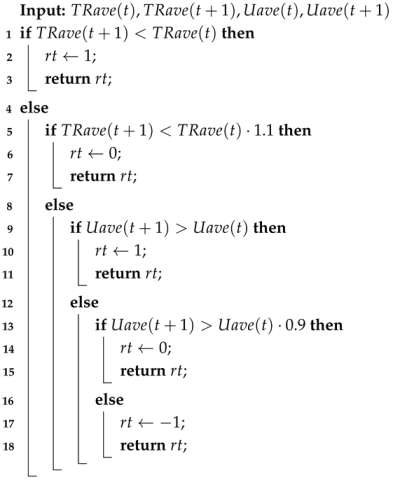 |
7. Conclusions
Author Contributions
Funding
Data Availability Statement
Conflicts of Interest
References
- Garey, M.R.; Johnson, D.S.; Sethi, R. The Complexity of Flowshop and Jobshop Scheduling. Math. Oper. Res. 1976, 1, 117–129. [Google Scholar] [CrossRef]
- Ouelhadj, D.; Petrovic, S. A survey of dynamic scheduling in manufacturing systems. J. Sched. 2009, 12, 417–431. [Google Scholar] [CrossRef]
- Lou, P.; Liu, Q.; Zhou, Z.; Wang, H.; Sun, S.X. Multi-agent-based proactive–reactive scheduling for a job shop. Int. J. Adv. Manuf. Technol. 2012, 59, 311–324. [Google Scholar] [CrossRef]
- Pezzella, F.; Morganti, G.; Ciaschetti, G. A genetic algorithm for the Flexible Job-shop Scheduling Problem. Comput. Oper. Res. 2008, 35, 3202–3212. [Google Scholar] [CrossRef]
- Kundakcı, N.; Kulak, O. Hybrid genetic algorithms for minimizing makespan in dynamic job shop scheduling problem. Comput. Ind. Eng. 2016, 96, 31–51. [Google Scholar] [CrossRef]
- Ning, T.; Huang, M.; Liang, X.; Jin, H. A novel dynamic scheduling strategy for solving flexible job-shop problems. J. Ambient Intell. Humaniz. Comput. 2016, 7, 721–729. [Google Scholar] [CrossRef]
- Cruz-Chávez, M.A.; Martínez-Rangel, M.G.; Cruz-Rosales, M.H. Accelerated simulated annealing algorithm applied to the flexible job shop scheduling problem. Int. Trans. Oper. Res. 2017, 24, 1119–1137. [Google Scholar] [CrossRef]
- Zhu, Z.; Zhou, X. An efficient evolutionary grey wolf optimizer for multi-objective flexible job shop scheduling problem with hierarchical job precedence constraints. Comput. Ind. Eng. 2020, 140, 106280. [Google Scholar] [CrossRef]
- El Khoukhi, F.; Boukachour, J.; Alaoui, A.E.H. The “Dual-Ants Colony”: A novel hybrid approach for the flexible job shop scheduling problem with preventive maintenance. Comput. Ind. Eng. 2017, 106, 236–255. [Google Scholar] [CrossRef]
- Zhang, S.; Li, X.; Zhang, B.; Wang, S. Multi-objective optimisation in flexible assembly job shop scheduling using a distributed ant colony system. Eur. J. Oper. Res. 2020, 283, 441–460. [Google Scholar] [CrossRef]
- Poppenborg, J.; Knust, S.; Hertzberg, J. Online scheduling of flexible job-shops with blocking and transportation. Eur. Ind. Eng. 2012, 6, 497–518. [Google Scholar] [CrossRef]
- Mohan, J.; Lanka, K.; Rao, A.N. A Review of Dynamic Job Shop Scheduling Techniques. Procedia Manuf. 2019, 30, 34–39. [Google Scholar] [CrossRef]
- Baker, K.R. Sequencing Rules and Due-Date Assignments in a Job Shop. Manag. Sci. 1984, 30, 1093–1104. [Google Scholar] [CrossRef]
- Nie, L.; Gao, L.; Li, P.; Li, X. A GEP-based reactive scheduling policies constructing approach for dynamic flexible job shop scheduling problem with job release dates. J. Intell. Manuf. 2013, 24, 763–774. [Google Scholar] [CrossRef]
- Sutton, R.S.; Barto, A.G. Reinforcement Learning: An Introduction; MIT Press: Cambridge, MA, USA, 2018. [Google Scholar]
- Aydin, M.; Öztemel, E. Dynamic job-shop scheduling using reinforcement learning agents. Robot. Auton. Syst. 2000, 33, 169–178. [Google Scholar] [CrossRef]
- Bouazza, W.; Sallez, Y.; Beldjilali, B. A distributed approach solving partially flexible job-shop scheduling problem with a Q-learning effect. IFAC-PapersOnLine 2017, 50, 15890–15895. [Google Scholar] [CrossRef]
- Wei, Y.; Zhao, M. Composite rules selection using reinforcement learning for dynamic job-shop scheduling. In Proceedings of the IEEE Conference on Robotics, Automation and Mechatronics, Singapore, 1–3 December 2004; Volume 2, pp. 1083–1088. [Google Scholar]
- Wang, Y.C.; Usher, J.M. Learning policies for single machine job dispatching. Robot. Comput.-Integr. Manuf. 2004, 20, 553–562. [Google Scholar] [CrossRef]
- Chen, R.; Yang, B.; Li, S.; Wang, S. A self-learning genetic algorithm based on reinforcement learning for flexible job-shop scheduling problem. Comput. Ind. Eng. 2020, 149, 106778. [Google Scholar] [CrossRef]
- Li, Y. Deep Reinforcement Learning: An Overview. arXiv 2017, arXiv:1701.07274. [Google Scholar]
- Wang, L.; Pan, Z.; Wang, J. A Review of Reinforcement Learning Based Intelligent Optimization for Manufacturing Scheduling. Complex Syst. Model. Simul. 2021, 1, 257–270. [Google Scholar] [CrossRef]
- Rafati, J.; Noelle, D.C. Learning representations in model-free hierarchical reinforcement learning. In Proceedings of the AAAI Conference on Artificial Intelligence, Honolulu, HI, USA, 27 January–1 February 2019; Volume 33, pp. 10009–10010. [Google Scholar]
- Li, A.C.; Florensa, C.; Clavera, I.; Abbeel, P. Sub-policy adaptation for hierarchical reinforcement learning. arXiv 2019, arXiv:1906.05862. [Google Scholar]
- Wei, Y.; Zhao, M. A reinforcement learning-based approach to dynamic job-shop scheduling. Acta Autom. Sin. 2005, 31, 765. [Google Scholar]
- Zhang, Z.; Zheng, L.; Weng, M.X. Dynamic parallel machine scheduling with mean weighted tardiness objective by Q-Learning. Int. J. Adv. Manuf. Technol. 2007, 34, 968–980. [Google Scholar] [CrossRef]
- Chen, X.; Hao, X.; Lin, H.W.; Murata, T. Rule driven multi objective dynamic scheduling by data envelopment analysis and reinforcement learning. In Proceedings of the 2010 IEEE International Conference on Automation and Logistics, Hong Kong, China, 16–20 August 2010; pp. 396–401. [Google Scholar] [CrossRef]
- Shahrabi, J.; Adibi, M.A.; Mahootchi, M. A reinforcement learning approach to parameter estimation in dynamic job shop scheduling. Comput. Ind. Eng. 2017, 110, 75–82. [Google Scholar] [CrossRef]
- Shiue, Y.R.; Lee, K.C.; Su, C.T. Real-time scheduling for a smart factory using a reinforcement learning approach. Comput. Ind. Eng. 2018, 125, 604–614. [Google Scholar] [CrossRef]
- Wang, Y.F. Adaptive job shop scheduling strategy based on weighted Q-learning algorithm. J. Intell. Manuf. 2020, 31, 417–432. [Google Scholar] [CrossRef]
- Waschneck, B.; Reichstaller, A.; Belzner, L.; Altenmüller, T.; Bauernhansl, T.; Knapp, A.; Kyek, A. Optimization of global production scheduling with deep reinforcement learning. Procedia CIRP 2018, 72, 1264–1269. [Google Scholar] [CrossRef]
- Altenmüller, T.; Stüker, T.; Waschneck, B.; Kuhnle, A.; Lanza, G. Reinforcement learning for an intelligent and autonomous production control of complex job-shops under time constraints. Prod. Eng. 2020, 14, 319–328. [Google Scholar] [CrossRef]
- Luo, S. Dynamic scheduling for flexible job shop with new job insertions by deep reinforcement learning. Appl. Soft Comput. 2020, 91, 106208. [Google Scholar] [CrossRef]
- Luo, S.; Zhang, L.; Fan, Y. Dynamic multi-objective scheduling for flexible job shop by deep reinforcement learning. Comput. Ind. Eng. 2021, 159, 107489. [Google Scholar] [CrossRef]
- Luo, S.; Zhang, L.; Fan, Y. Real-time scheduling for dynamic partial-no-wait multiobjective flexible job shop by deep reinforcement learning. IEEE Trans. Autom. Sci. Eng. 2022, 19, 3020–3038. [Google Scholar] [CrossRef]
- Li, Y.; Gu, W.; Yuan, M.; Tang, Y. Real-time data-driven dynamic scheduling for flexible job shop with insufficient transportation resources using hybrid deep Q network. Robot. Comput.-Integr. Manuf. 2022, 74, 102283. [Google Scholar] [CrossRef]
- Zhao, L.; Fan, J.; Zhang, C.; Shen, W.; Zhuang, J. A DRL-Based Reactive Scheduling Policy for Flexible Job Shops with Random Job Arrivals. IEEE Trans. Autom. Sci. Eng. 2023, 21, 2912–2923. [Google Scholar] [CrossRef]
- Wu, Z.; Fan, H.; Sun, Y.; Peng, M. Efficient Multi-Objective Optimization on Dynamic Flexible Job Shop Scheduling Using Deep Reinforcement Learning Approach. Processes 2023, 11, 2018. [Google Scholar] [CrossRef]
- Bellman, R. A Markovian decision process. J. Math. Mech. 1957, 6, 679–684. [Google Scholar] [CrossRef]
- Mnih, V.; Kavukcuoglu, K.; Silver, D.; Graves, A.; Antonoglou, I.; Wierstra, D.; Riedmiller, M. Playing Atari with Deep Reinforcement Learning. arXiv 2013, arXiv:1312.5602. [Google Scholar]
- Hasselt, H. Double Q-learning. In Advances in Neural Information Processing Systems 23, Proceedings of the 24th Annual Conference on Neural Information Processing Systems 2010, Vancouver, BC, Canada, 6–9 December 2010; Lafferty, J., Williams, C., Shawe-Taylor, J., Zemel, R., Culotta, A., Eds.; Neural Information Processing Systems Foundation, Inc. (NeurIPS): San Diego, CA, USA, 2010. [Google Scholar]
- Van Hasselt, H.; Guez, A.; Silver, D. Deep reinforcement learning with double q-learning. In Proceedings of the AAAI Conference on Artificial Intelligence, Phoenix, AZ, USA, 12–17 February 2016; Volume 30. [Google Scholar] [CrossRef]
- Wang, H.; Cheng, J.; Liu, C.; Zhang, Y.; Hu, S.; Chen, L. Multi-objective reinforcement learning framework for dynamic flexible job shop scheduling problem with uncertain events. Appl. Soft Comput. 2022, 131, 109717. [Google Scholar] [CrossRef]

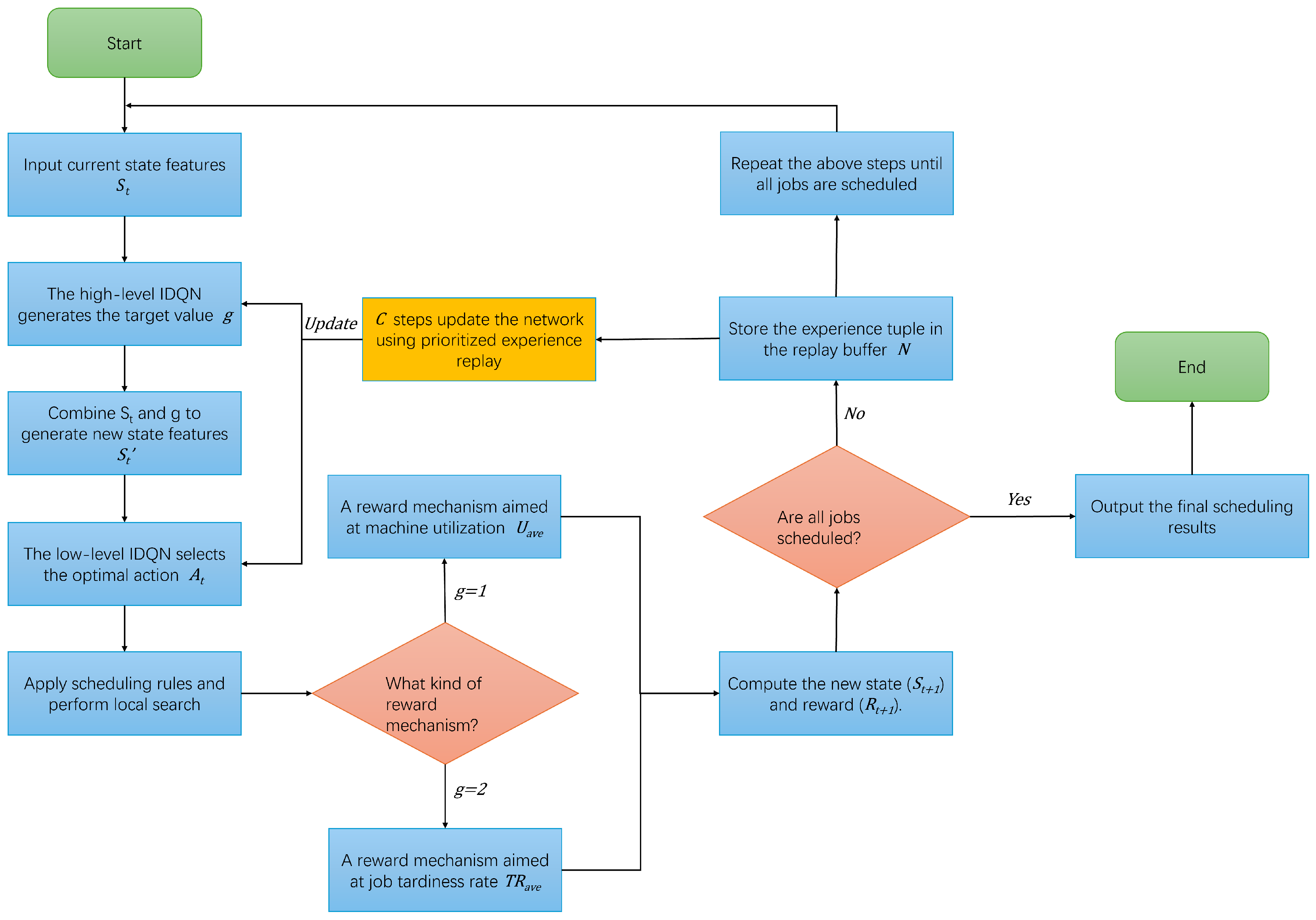
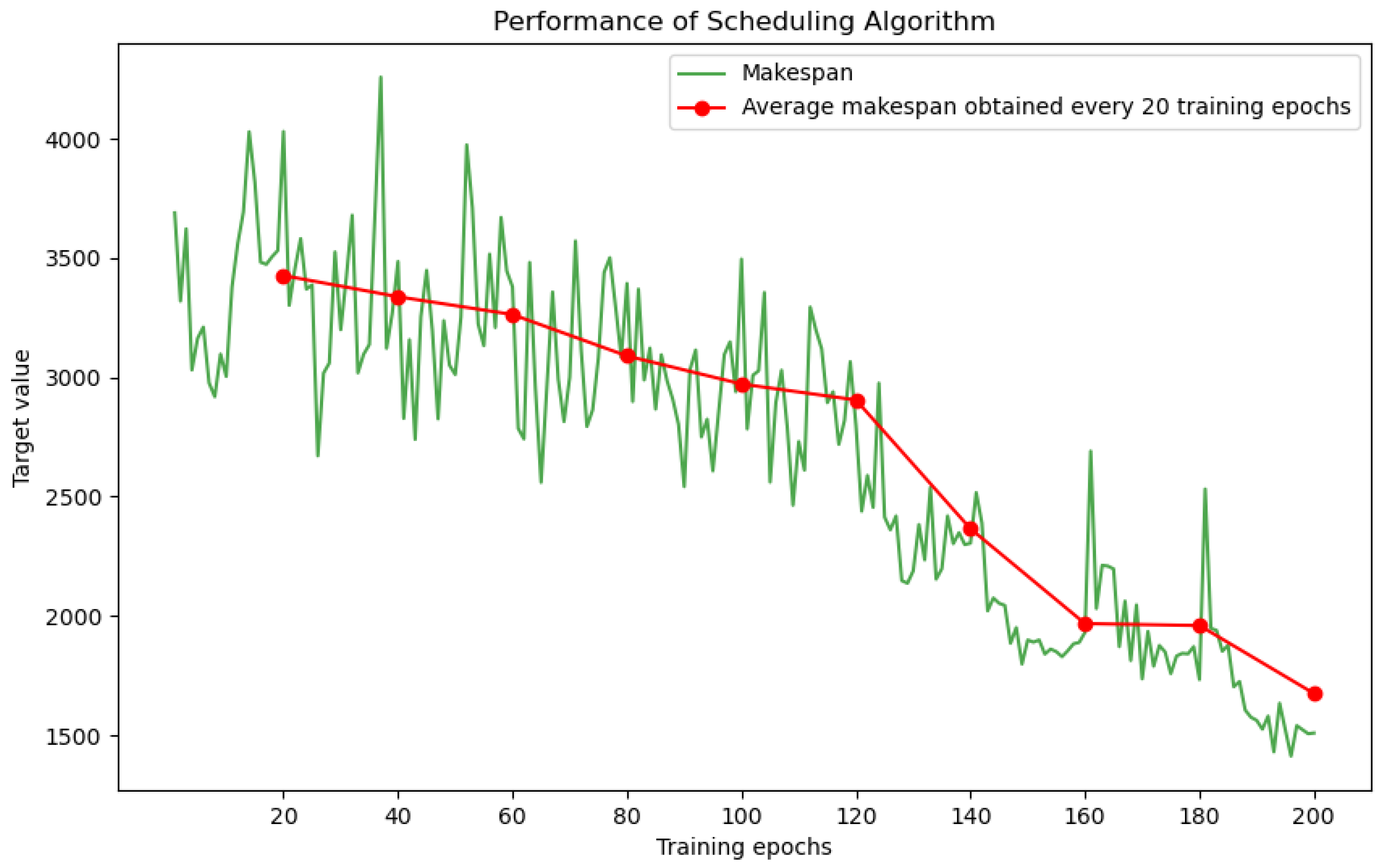
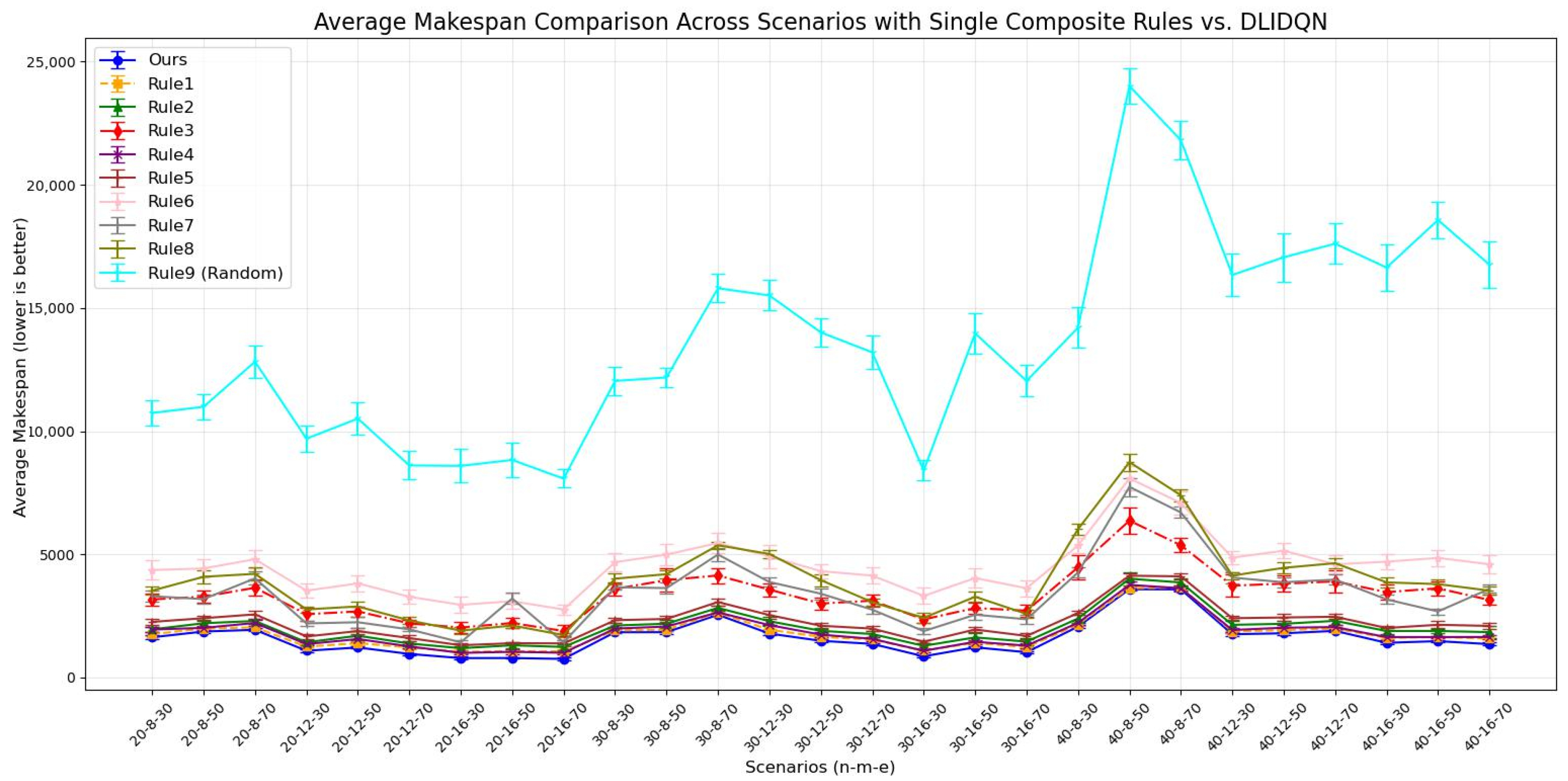
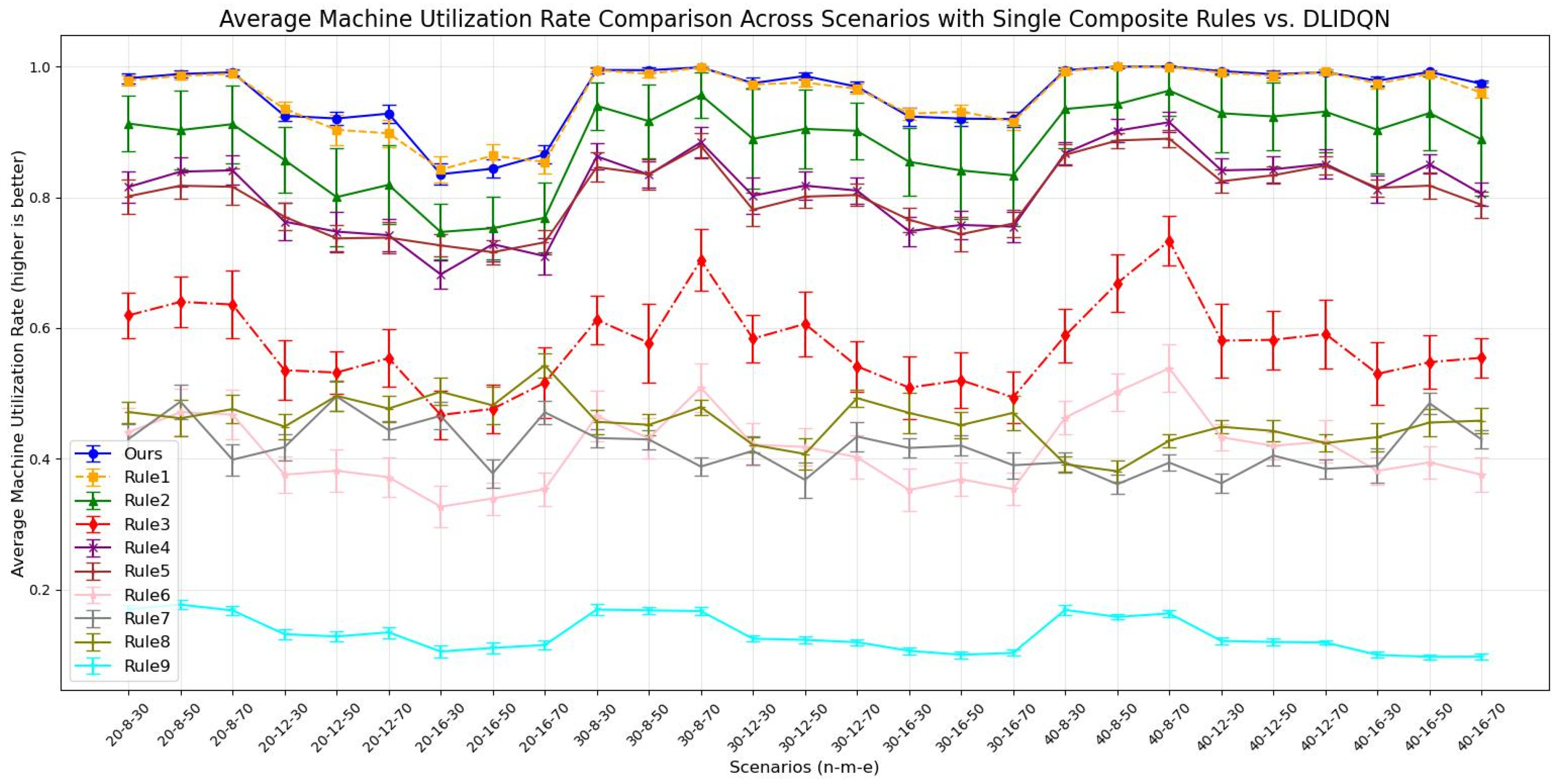
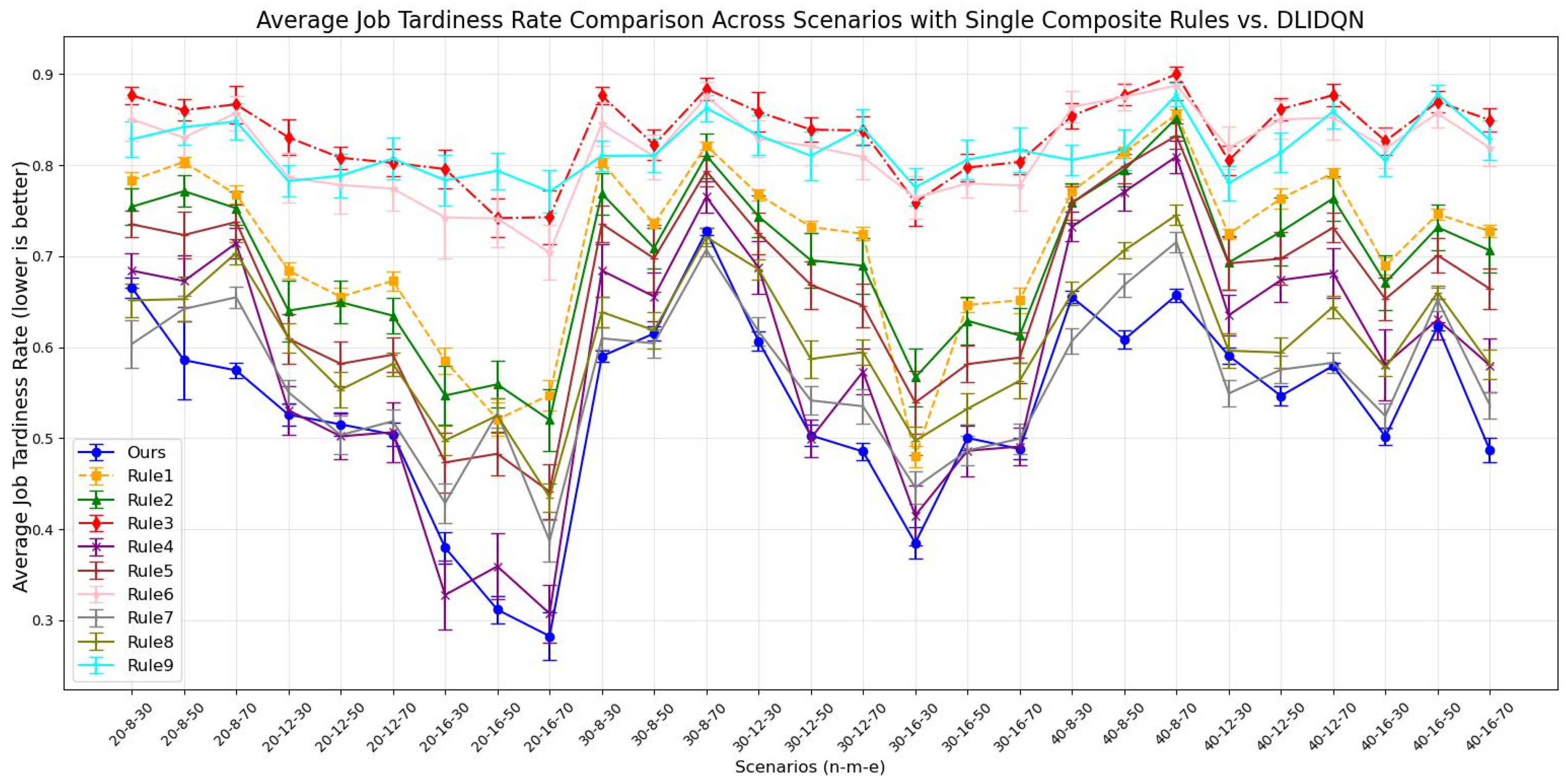

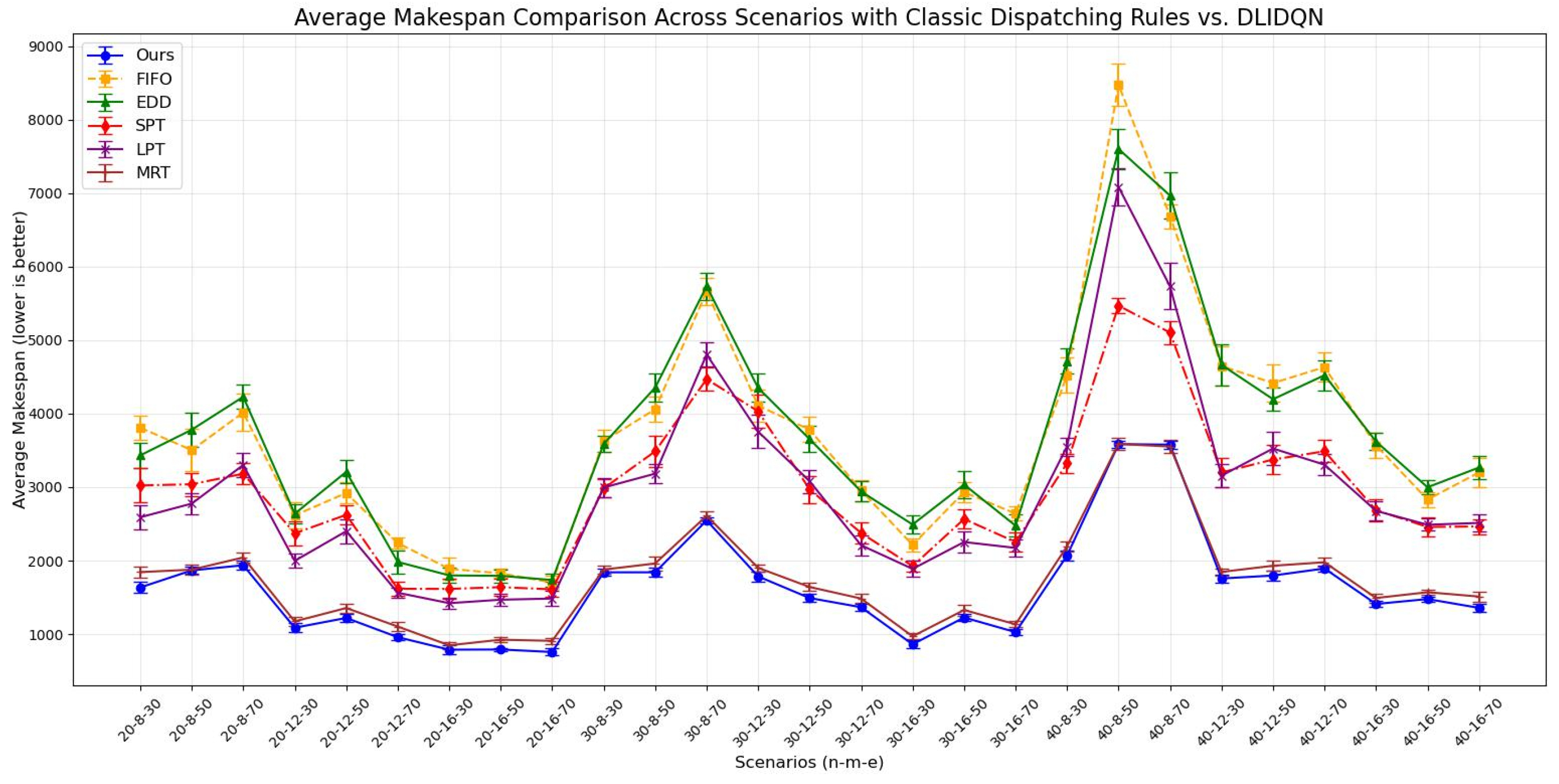
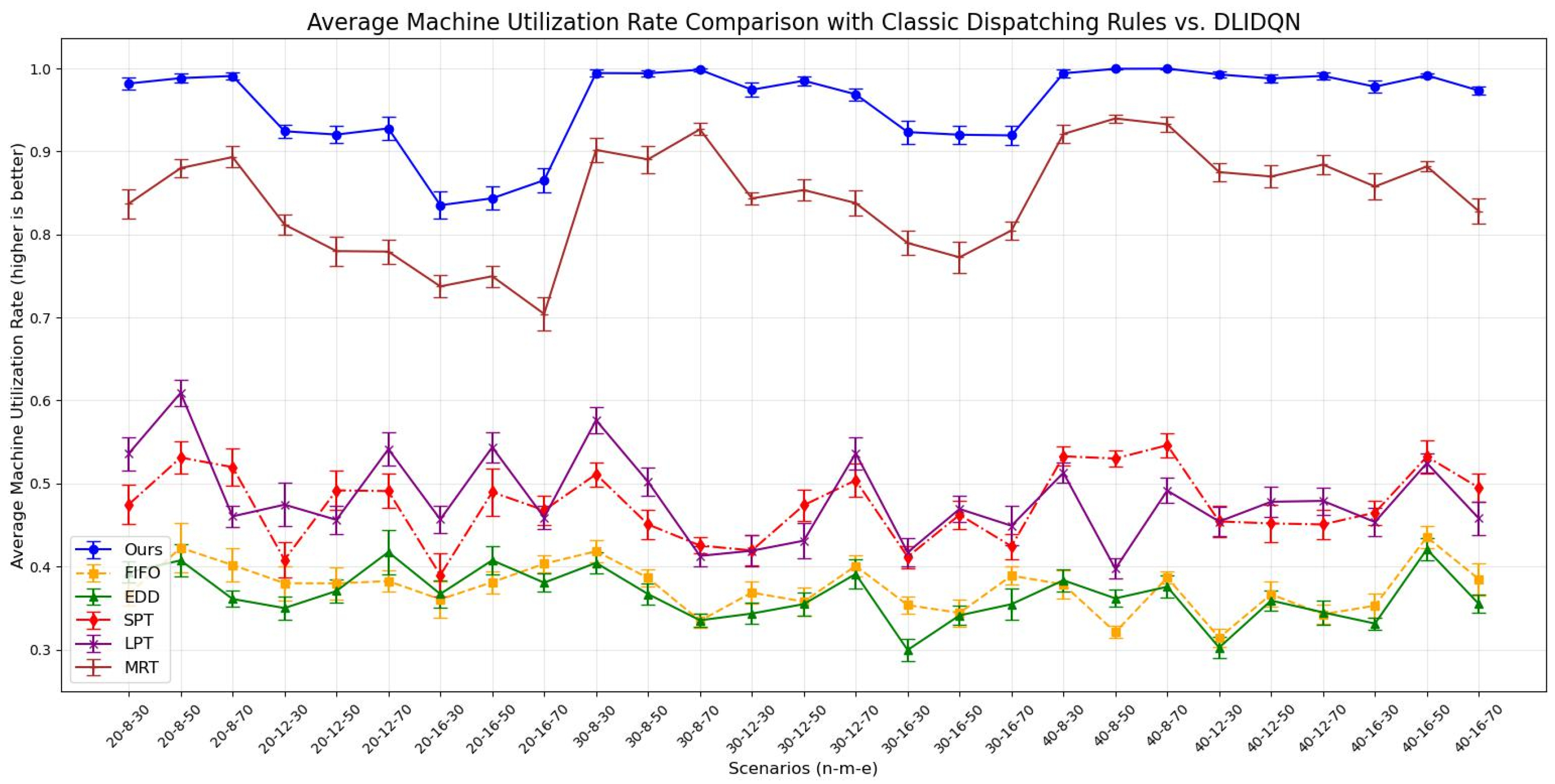


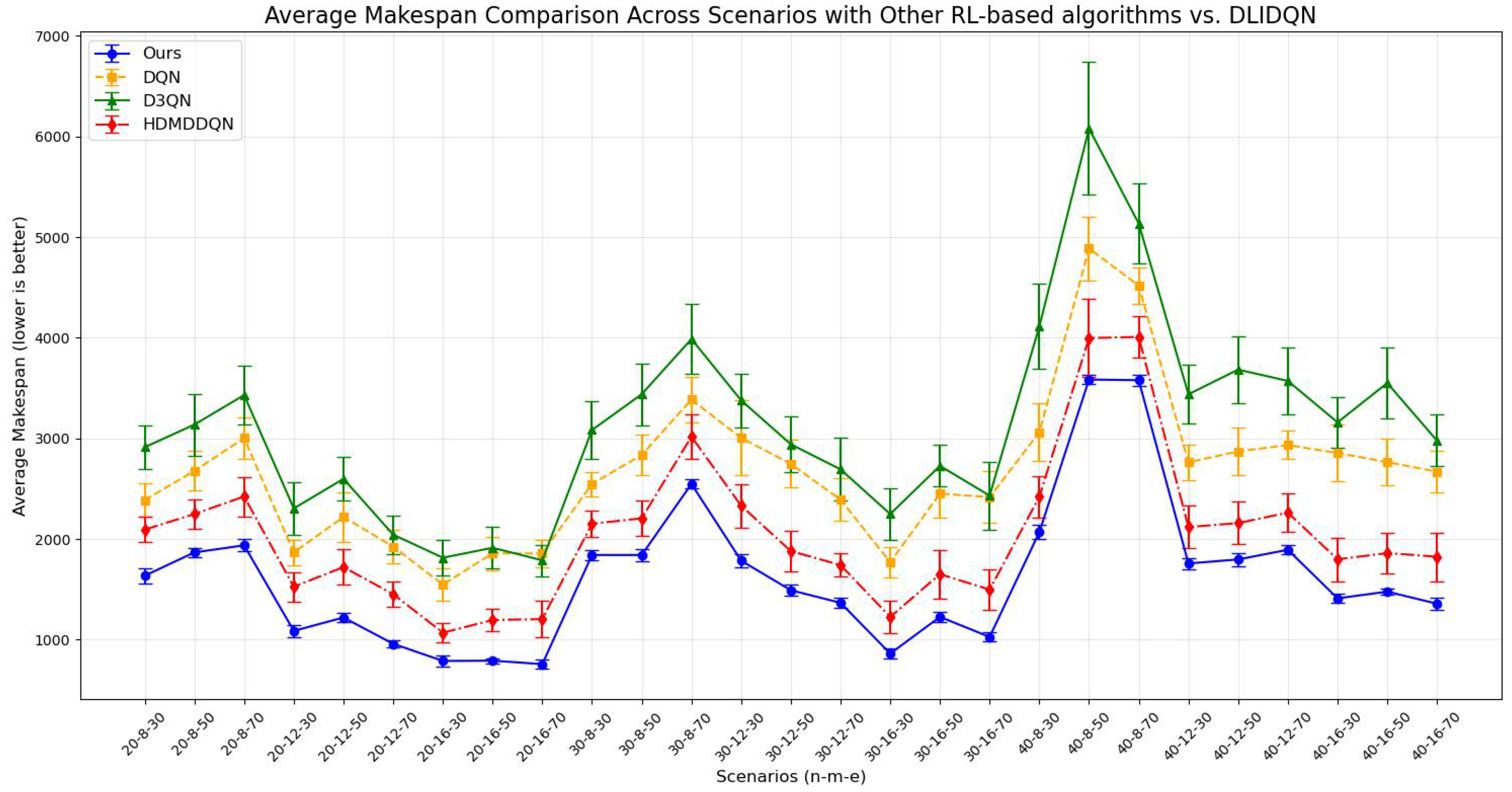


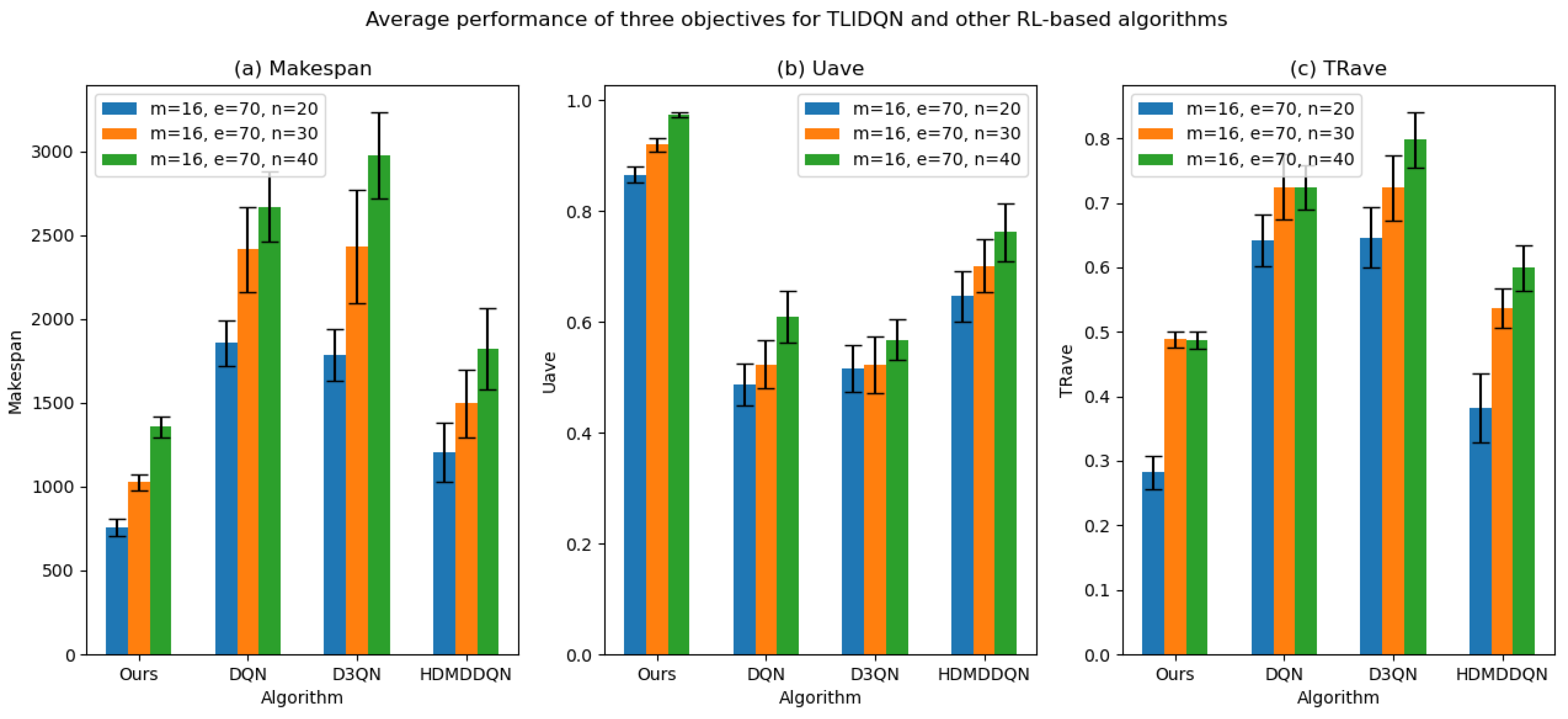

| Work | Algorithm | Problem | Objective | Dynamic Events |
|---|---|---|---|---|
| Aydin and Oztemel (2000) [16] | Q-learning | Dynamic job scheduling | Mean tardiness | New job insertions |
| Bouazza et al. (2017) [17] | Q-learning | Dynamic multi-objective flexible job scheduling | Makespan; Total weighted completion time; Weighted average waiting time | New job insertions |
| Yingzi and Mingyang (2004) [18] | Q-learning | Dynamic job scheduling | Mean tardiness | New job insertions |
| Wang (2020) [30] | Q-learning | Dynamic job scheduling | Earliness punishment; Tardiness punishment | New job insertions |
| Zhang et al. (2007) [26] | Q-learning | Dynamic parallel-machine scheduling | Mean weighted tardiness | Sequence-dependent setup times; Machine job qualification |
| Chen et al. (2010) [27] | Q-learning | Dynamic multi-objective job scheduling | Mean tardiness; Mean flow time | Fluctuation of work in process |
| Shahrabi et al. (2017) [28] | Q-learning | Dynamic job scheduling | Mean flow time | New job insertions; Machine breakdowns |
| Waschneck et al. (2018) [31] | Deep Q-learning | Dynamic flexible job scheduling | Uptime utilization | Machine breakdowns |
| Altenmüller et al. (2020) [32] | Deep Q-learning | Dynamic job scheduling | Count of violation events | New job insertions; Machine breakdowns |
| Luo (2020) [33] | DQN | Dynamic multi-objective flexible job scheduling | Total tardiness | New job insertions |
| Luo et al. (2021) [34] | THDQN | Dynamic flexible job scheduling | Total weighted tardiness rate; Average machine utilization | New job insertions |
| Luo et al. (2021b) [35] | HMAPPO | Dynamic partial-no-wait multi-objective flexible job shop scheduling (DMOFJSP-PNW) | Total weighted tardiness; Average machine utilization rate; Variance of machine workload | New job insertions; Machine breakdowns |
| Li et al. (2022) [36] | HDQN | Dynamic multi-objective flexible job scheduling | Completion time; Total energy | Insufficient transportation resources |
| Wu et al. (2023) [38] | Dual layer DDQN | Dynamic multi-objective flexible job scheduling | Maximum completion time; Total tardiness | Random workpiece arrivals |
| Parameter | Definition |
|---|---|
| n | The total number of jobs |
| m | The total number of machines |
| The i-th job | |
| The j-th operation of job | |
| The number of operations for job | |
| The k-th machine | |
| The set of compatible machines for operation | |
| The processing time of operation on machine | |
| The arrival time of job | |
| The urgency of job is classified into three levels: level 1 being the most urgent, and level 3 being the least. Jobs with higher urgency are assigned shorter due dates | |
| Due date tightness (DDT) is an indicator that measures the relationship between a job’s due date and its estimated completion time. A lower DDT value indicates a tighter due date, leaving less time to complete the task, whereas a higher DDT value suggests that the job has more flexibility in completing the task | |
| The due date of job | |
| The number of operations completed for the job at the current time | |
| Determine whether the operation is being processed on machine . If is assigned to machine , then ; otherwise, | |
| Determine the relative priority between operations and . If is a predecessor of , then ; if is a successor of , then | |
| The completion time of operation | |
| The utilization of machine | |
| The processing tardiness rate of job |
| Parameter | Value |
|---|---|
| The total number of initial jobs | Unif [1, 20] |
| The total number of machines | Unif [8, 16] |
| Number of operations belonging to a job | Unif [1, 20] |
| Available machines per operation | Unif [1, m−2] |
| Operation time on an available machine | Unif [1, 50] |
| Urgency degree of each job | [1, 2, 3] |
| Due date tightness () | [0.7, 1.2, 1.7] |
| Mean value () of the interarrival time | [30, 50, 70] |
| Machine repair time | Unif [1, 99] |
| Tool replacement time | Unif [1, 50] |
| Hyperparameter | Value |
|---|---|
| Number of training epochs (L) | 20 |
| Priority experience replay buffer size (N) | 2000 |
| Minibatch size to perform gradient descent (batch_size) | 32 |
| Controls the influence of sample prioritization () | 0.6 |
| Adjusts the correction level of importance sampling () | 0.4 |
| Epsilon in -greedy action policy () | Linear drop from 0.6 to 0.01 |
| Target network update frequency (C) | 200 |
| Discount rate () | 0.95 |
| Learning rate () | 0.001 |
| Optimizer | Adam |
| Parameter | Value |
|---|---|
| The total number of initial jobs | Unif [1, 20] |
| The total number of machines | [8, 12, 16] |
| Number of operations belonging to a job | Unif [1, 20] |
| Number of available machines of each operation | Unif [1, m−2] |
| Processing time of an operation on an available machine | Unif [1, 50] |
| Urgency degree of each job | [1, 2, 3] |
| Due date tightness () | [0.7, 1.2, 1.7] |
| Mean value () of the interarrival time | [30, 50, 70] |
| The total number of new insert jobs | [20, 30, 40] |
| Machine repair time | Unif [1, 99] |
| Tool replacement time | Unif [1, 50] |
| n | m | e | Ours | rule1 | rule2 | rule3 | rule4 | rule5 | rule6 | rule7 | rule8 | rule9 (Random) |
|---|---|---|---|---|---|---|---|---|---|---|---|---|
| 20 | 8 | 30 | ||||||||||
| 50 | ||||||||||||
| 70 | ||||||||||||
| 12 | 30 | |||||||||||
| 50 | ||||||||||||
| 70 | ||||||||||||
| 16 | 30 | |||||||||||
| 50 | ||||||||||||
| 70 | ||||||||||||
| 30 | 8 | 30 | ||||||||||
| 50 | ||||||||||||
| 70 | ||||||||||||
| 12 | 30 | |||||||||||
| 50 | ||||||||||||
| 70 | ||||||||||||
| 16 | 30 | |||||||||||
| 50 | ||||||||||||
| 70 | ||||||||||||
| 40 | 8 | 30 | ||||||||||
| 50 | ||||||||||||
| 70 | ||||||||||||
| 12 | 30 | |||||||||||
| 50 | ||||||||||||
| 70 | ||||||||||||
| 16 | 30 | |||||||||||
| 50 | ||||||||||||
| 70 |
| n | m | e | Ours | rule1 | rule2 | rule3 | rule4 | rule5 | rule6 | rule7 | rule8 | rule9 |
|---|---|---|---|---|---|---|---|---|---|---|---|---|
| 20 | 8 | 30 | ||||||||||
| 50 | ||||||||||||
| 70 | ||||||||||||
| 12 | 30 | |||||||||||
| 50 | ||||||||||||
| 70 | ||||||||||||
| 16 | 30 | |||||||||||
| 50 | ||||||||||||
| 70 | ||||||||||||
| 30 | 8 | 30 | ||||||||||
| 50 | ||||||||||||
| 70 | ||||||||||||
| 12 | 30 | |||||||||||
| 50 | ||||||||||||
| 70 | ||||||||||||
| 16 | 30 | |||||||||||
| 50 | ||||||||||||
| 70 | ||||||||||||
| 40 | 8 | 30 | ||||||||||
| 50 | ||||||||||||
| 70 | ||||||||||||
| 12 | 30 | |||||||||||
| 50 | ||||||||||||
| 70 | ||||||||||||
| 16 | 30 | |||||||||||
| 50 | ||||||||||||
| 70 |
| n | m | e | Ours | rule1 | rule2 | rule3 | rule4 | rule5 | rule6 | rule7 | rule8 | rule9 |
|---|---|---|---|---|---|---|---|---|---|---|---|---|
| 20 | 8 | 30 | ||||||||||
| 50 | ||||||||||||
| 70 | ||||||||||||
| 12 | 30 | |||||||||||
| 50 | ||||||||||||
| 70 | ||||||||||||
| 16 | 30 | |||||||||||
| 50 | ||||||||||||
| 70 | ||||||||||||
| 30 | 8 | 30 | ||||||||||
| 50 | ||||||||||||
| 70 | ||||||||||||
| 12 | 30 | |||||||||||
| 50 | ||||||||||||
| 70 | ||||||||||||
| 16 | 30 | |||||||||||
| 50 | ||||||||||||
| 70 | ||||||||||||
| 40 | 8 | 30 | ||||||||||
| 50 | ||||||||||||
| 70 | ||||||||||||
| 12 | 30 | |||||||||||
| 50 | ||||||||||||
| 70 | ||||||||||||
| 16 | 30 | |||||||||||
| 50 | ||||||||||||
| 70 |
| n | m | e | Ours | FIFO | EDD | SPT | LPT | MRT |
|---|---|---|---|---|---|---|---|---|
| 20 | 8 | 30 | ||||||
| 50 | ||||||||
| 70 | ||||||||
| 12 | 30 | |||||||
| 50 | ||||||||
| 70 | ||||||||
| 16 | 30 | |||||||
| 50 | ||||||||
| 70 | ||||||||
| 30 | 8 | 30 | ||||||
| 50 | ||||||||
| 70 | ||||||||
| 12 | 30 | |||||||
| 50 | ||||||||
| 70 | ||||||||
| 16 | 30 | |||||||
| 50 | ||||||||
| 70 | ||||||||
| 40 | 8 | 30 | ||||||
| 50 | ||||||||
| 70 | ||||||||
| 12 | 30 | |||||||
| 50 | ||||||||
| 70 | ||||||||
| 16 | 30 | |||||||
| 50 | ||||||||
| 70 |
| n | m | e | Ours | FIFO | EDD | SPT | LPT | MRT |
|---|---|---|---|---|---|---|---|---|
| 20 | 8 | 30 | ||||||
| 50 | ||||||||
| 70 | ||||||||
| 12 | 30 | |||||||
| 50 | ||||||||
| 70 | ||||||||
| 16 | 30 | |||||||
| 50 | ||||||||
| 70 | ||||||||
| 30 | 8 | 30 | ||||||
| 50 | ||||||||
| 70 | ||||||||
| 12 | 30 | |||||||
| 50 | ||||||||
| 70 | ||||||||
| 16 | 30 | |||||||
| 50 | ||||||||
| 70 | ||||||||
| 40 | 8 | 30 | ||||||
| 50 | ||||||||
| 70 | ||||||||
| 12 | 30 | |||||||
| 50 | ||||||||
| 70 | ||||||||
| 16 | 30 | |||||||
| 50 | ||||||||
| 70 |
| n | m | e | Ours | FIFO | EDD | SPT | LPT | MRT |
|---|---|---|---|---|---|---|---|---|
| 20 | 8 | 30 | ||||||
| 50 | ||||||||
| 70 | ||||||||
| 12 | 30 | |||||||
| 50 | ||||||||
| 70 | ||||||||
| 16 | 30 | |||||||
| 50 | ||||||||
| 70 | ||||||||
| 30 | 8 | 30 | ||||||
| 50 | ||||||||
| 70 | ||||||||
| 12 | 30 | |||||||
| 50 | ||||||||
| 70 | ||||||||
| 16 | 30 | |||||||
| 50 | ||||||||
| 70 | ||||||||
| 40 | 8 | 30 | ||||||
| 50 | ||||||||
| 70 | ||||||||
| 12 | 30 | |||||||
| 50 | ||||||||
| 70 | ||||||||
| 16 | 30 | |||||||
| 50 | ||||||||
| 70 |
| n | m | e | Ours | DQN | D3QN | HDMDDQN |
|---|---|---|---|---|---|---|
| 20 | 8 | 30 | ||||
| 50 | ||||||
| 70 | ||||||
| 12 | 30 | |||||
| 50 | ||||||
| 70 | ||||||
| 16 | 30 | |||||
| 50 | ||||||
| 70 | ||||||
| 30 | 8 | 30 | ||||
| 50 | ||||||
| 70 | ||||||
| 12 | 30 | |||||
| 50 | ||||||
| 70 | ||||||
| 16 | 30 | |||||
| 50 | ||||||
| 70 | ||||||
| 40 | 8 | 30 | ||||
| 50 | ||||||
| 70 | ||||||
| 12 | 30 | |||||
| 50 | ||||||
| 70 | ||||||
| 16 | 30 | |||||
| 50 | ||||||
| 70 |
| n | m | e | Ours | DQN | D3QN | HDMDDQN |
|---|---|---|---|---|---|---|
| 20 | 8 | 30 | ||||
| 50 | ||||||
| 70 | ||||||
| 12 | 30 | |||||
| 50 | ||||||
| 70 | ||||||
| 16 | 30 | |||||
| 50 | ||||||
| 70 | ||||||
| 30 | 8 | 30 | ||||
| 50 | ||||||
| 70 | ||||||
| 12 | 30 | |||||
| 50 | ||||||
| 70 | ||||||
| 16 | 30 | |||||
| 50 | ||||||
| 70 | ||||||
| 40 | 8 | 30 | ||||
| 50 | ||||||
| 70 | ||||||
| 12 | 30 | |||||
| 50 | ||||||
| 70 | ||||||
| 16 | 30 | |||||
| 50 | ||||||
| 70 |
| n | m | e | Ours | DQN | D3QN | HDMDDQN |
|---|---|---|---|---|---|---|
| 20 | 8 | 30 | ||||
| 50 | ||||||
| 70 | ||||||
| 12 | 30 | |||||
| 50 | ||||||
| 70 | ||||||
| 16 | 30 | |||||
| 50 | ||||||
| 70 | ||||||
| 30 | 8 | 30 | ||||
| 50 | ||||||
| 70 | ||||||
| 12 | 30 | |||||
| 50 | ||||||
| 70 | ||||||
| 16 | 30 | |||||
| 50 | ||||||
| 70 | ||||||
| 40 | 8 | 30 | ||||
| 50 | ||||||
| 70 | ||||||
| 12 | 30 | |||||
| 50 | ||||||
| 70 | ||||||
| 16 | 30 | |||||
| 50 | ||||||
| 70 |
Disclaimer/Publisher’s Note: The statements, opinions and data contained in all publications are solely those of the individual author(s) and contributor(s) and not of MDPI and/or the editor(s). MDPI and/or the editor(s) disclaim responsibility for any injury to people or property resulting from any ideas, methods, instructions or products referred to in the content. |
© 2025 by the authors. Licensee MDPI, Basel, Switzerland. This article is an open access article distributed under the terms and conditions of the Creative Commons Attribution (CC BY) license (https://creativecommons.org/licenses/by/4.0/).
Share and Cite
Xu, H.; Zheng, J.; Huang, L.; Tao, J.; Zhang, C. Solving Dynamic Multi-Objective Flexible Job Shop Scheduling Problems Using a Dual-Level Integrated Deep Q-Network Approach. Processes 2025, 13, 386. https://doi.org/10.3390/pr13020386
Xu H, Zheng J, Huang L, Tao J, Zhang C. Solving Dynamic Multi-Objective Flexible Job Shop Scheduling Problems Using a Dual-Level Integrated Deep Q-Network Approach. Processes. 2025; 13(2):386. https://doi.org/10.3390/pr13020386
Chicago/Turabian StyleXu, Hua, Jianlu Zheng, Lingxiang Huang, Juntai Tao, and Chenjie Zhang. 2025. "Solving Dynamic Multi-Objective Flexible Job Shop Scheduling Problems Using a Dual-Level Integrated Deep Q-Network Approach" Processes 13, no. 2: 386. https://doi.org/10.3390/pr13020386
APA StyleXu, H., Zheng, J., Huang, L., Tao, J., & Zhang, C. (2025). Solving Dynamic Multi-Objective Flexible Job Shop Scheduling Problems Using a Dual-Level Integrated Deep Q-Network Approach. Processes, 13(2), 386. https://doi.org/10.3390/pr13020386





